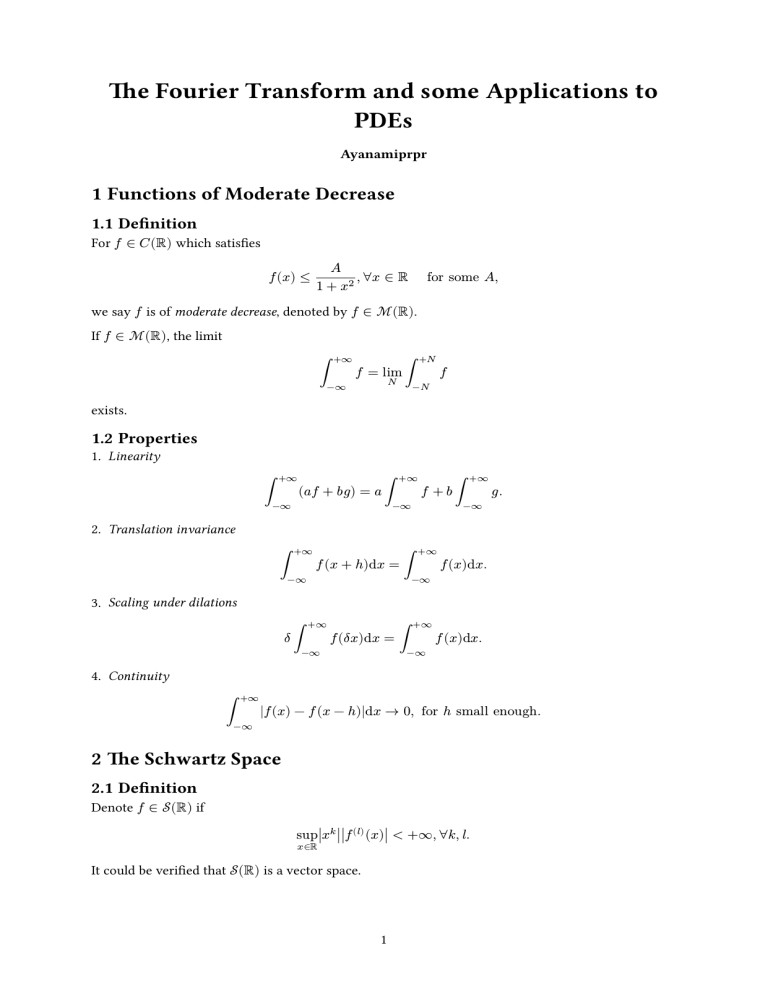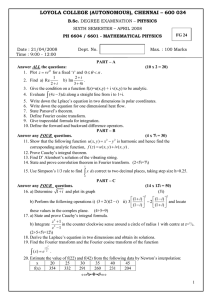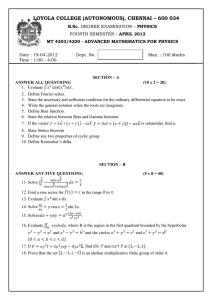
The Fourier Transform and some Applications to
PDEs
Ayanamiprpr
1 Functions of Moderate Decrease
1.1 Definition
For 𝑓 ∈ 𝐶(ℝ) which satisfies
𝑓(𝑥) ≤
𝐴
, ∀𝑥 ∈ ℝ
1 + 𝑥2
for some 𝐴,
we say 𝑓 is of moderate decrease, denoted by 𝑓 ∈ ℳ(ℝ).
If 𝑓 ∈ ℳ(ℝ), the limit
+∞
∫
+𝑁
𝑓 = lim ∫
𝑁
−∞
𝑓
−𝑁
exists.
1.2 Properties
1. Linearity
+∞
∫
+∞
+∞
(𝑎𝑓 + 𝑏𝑔) = 𝑎 ∫
−∞
𝑓 +𝑏∫
−∞
𝑔.
−∞
2. Translation invariance
+∞
∫
+∞
𝑓(𝑥 + ℎ)d𝑥 = ∫
−∞
𝑓(𝑥)d𝑥.
−∞
3. Scaling under dilations
+∞
𝛿∫
+∞
𝑓(𝛿𝑥)d𝑥 = ∫
−∞
𝑓(𝑥)d𝑥.
−∞
4. Continuity
+∞
∫
|𝑓(𝑥) − 𝑓(𝑥 − ℎ)|d𝑥 → 0, for ℎ small enough.
−∞
2 The Schwartz Space
2.1 Definition
Denote 𝑓 ∈ 𝒮(ℝ) if
sup|𝑥𝑘 ||𝑓 (𝑙) (𝑥)| < +∞, ∀𝑘, 𝑙.
𝑥∈ℝ
It could be verified that 𝒮(ℝ) is a vector space.
1
2.2 Example
The Guassian defined by
2
𝑓(𝑥) = 𝑒−𝑥
is in 𝒮(ℝ).
2
(use series expansion to show that 𝑃 (𝑥)𝑒−𝑥 → 0 for any polynomial 𝑃 (𝑥).)
3 The Fourier Transform on 𝒮(ℝ)
3.1 Definition
The Fourier transform of 𝑓 ∈ 𝒮(ℝ) is defined by
+∞
̂ =∫
𝑓(𝜉)
𝑓(𝑥)𝑒−2𝜋𝑖𝑥𝜉 d𝑥.
−∞
3.2 Properties
2𝜋𝑖ℎ𝜉
̂
1. 𝑓(𝑥 + ℎ) → 𝑓(𝜉)𝑒
̂ + ℎ)
2. 𝑓(𝑥)𝑒−2𝜋𝑖𝑥ℎ → 𝑓(𝜉
̂ −1 𝜉)
3. 𝑓(𝛿𝑥) → 𝛿 −1 𝑓(𝛿
̂
4. 𝑓 ′ (𝑥) → 2𝜋𝑖𝜉 𝑓(𝜉)
5. −2𝜋𝑖𝑥𝑓(𝑥) → 𝑓 ′̂ (𝜉)
3.3 Theorem
If 𝑓 ∈ 𝒮(ℝ), then 𝑓 ̂ ∈ 𝒮(ℝ).
Proof. Use 3.2, 5., 4. to show that
(𝜉)𝑘 (
d 𝑙 ̂
) 𝑓(𝜉) < +∞.
d𝜉
4 The Good Kernels
4.1 Definition
A family of functions (𝐾𝛿 ) defined on ℝ is family of good kernels if
+∞
1. ∫
𝐾𝛿 = 1,
2. ∫
|𝐾𝛿 | < +∞,
3. ∫
|𝐾𝛿 (𝑥)|d𝑥 → 0 as 𝛿 → 0 for all 𝜂.
−∞
+∞
−∞
𝑥>|𝜂|
4.2 Theorem
If 𝑓 ∈ 𝒮(ℝ), then
+∞
(𝑓 ∗ 𝐾𝛿 )(𝑥) = ∫
𝑓(𝑥 − 𝑡)𝐾𝛿 (𝑡)d𝑡 → 𝑓(𝑥) 𝑢𝑛𝑖𝑓𝑜𝑟𝑚𝑙𝑦.
−∞
4.3 Proposition
2
̂ = 𝑓(𝜉).
Let 𝑓(𝑥) = 𝑒−𝜋𝑥 , then 𝑓(𝜉)
2
1
𝑥2
̂𝛿 (𝜉) = 𝑒−𝜋𝑖𝛿𝜉 .
Let 𝐾𝛿 (𝑥) = 𝛿 − 2 𝑒−𝜋𝑖 𝛿 , we have 𝐾
2
4.4 Theorem
(𝐾𝛿 ) given in 4.3 is a family of good kernels.
5 The Fourier Inversion
5.1 Proposition
For 𝑓, 𝑔 ∈ 𝒮(ℝ),
+∞
∫
+∞
𝑓(𝑥)𝑔(𝑥)d𝑥
=∫
̂
−∞
̂
𝑓(𝑥)𝑔(𝑥)d𝑥.
−∞
5.2 Proposition
If 𝑓 ∈ 𝒮(ℝ), then
+∞
𝑓(0) = ∫
̂
𝑓(𝑥)d𝑥.
−∞
5.3 Theorem (Fourier inversion)
If 𝑓 ∈ 𝒮(ℝ), then
+∞
𝑓(𝑥) = ∫
2𝜋𝑖𝑥𝜉
̂
𝑓(𝜉)𝑒
d𝜉.
−∞
Let
+∞
𝑓(𝑥)𝑒−2𝜋𝑖𝑥𝜉 d𝑥
ℱ(𝑓)(𝜉) = ∫
−∞
denote the Fourier transform, and ℱ∗ its inversion, it’s known from the above theorem, and that
𝑓 ̂ ∈ 𝒮(ℝ), the Fourier transfrom is a bijective mapping from 𝒮(ℝ) to itself.
6 The Plancherel Formula
6.1 Lemma
If 𝑓 ∈ 𝒮(ℝ), then
sup |𝑥|𝑙 |𝑓(𝑥 − 𝑦)| ≤ 𝐴𝑙 (1 + |𝑦|)𝑙
𝑥
for 𝑙 ≥ 0.
6.2 Proposition
Let 𝑓, 𝑔 ∈ 𝒮(ℝ), we have
1. 𝑓 ∗ 𝑔 ∈ 𝒮(ℝ).
2. 𝑓 ∗ 𝑔 = 𝑔 ∗ 𝑓.
̂ ̂
3. 𝑓̂
∗ 𝑔 = 𝑓 𝑔.
Proof. For 1., use the lemme 6.1 to estimate
3
|𝑥|𝑙 |
∞
d
d
(𝑓 ∗ 𝑔)(𝑥)| = ∫ |𝑥|𝑙 𝑓(𝑥 − 𝑡)𝑔(𝑡)d𝑡.
d𝑥
d𝑥
−∞
For 2., note that
∞
∞
∫
𝑓(𝑥 − 𝑡)𝑔(𝑡)d𝑡 = ∫
−∞
𝑓(𝑡)𝑔(𝑥 − 𝑡)d𝑡.
−∞
For 3. let
𝐹 (𝑥, 𝑦) = 𝑓(𝑥 − 𝑦)𝑔(𝑦)𝑒−2𝜋𝑖𝑥𝜉 ,
then (as 𝐹 is continuous and of moderate decrease)
∞
∞
∫ (∫
−∞
𝐹 d𝑦)d𝑥 = (𝑓̂
∗ 𝑔)(𝜉)
−∞
∞
∞
= ∫ (∫
−∞
𝐹 d𝑥)d𝑦
−∞
̂ 𝑔(𝜉).
= 𝑓(𝜉)
̂
6.3 Theorem (Plancherel)
For 𝑓 ∈ 𝒮(ℝ), ‖𝑓‖ = ‖𝑓‖.̂
Proof. Investigate
𝑓 ̃ = 𝑓(−𝑥),
̃
ℎ = (𝑓 ∗ 𝑓).
7 Applications to some PDEs
7.1 Time dependent heat equations
For
2
⎧
= 𝜕𝜕𝑥𝑢2
{ 𝜕𝑢
𝜕𝑡
⎨
{
⎩𝑢(𝑥, 0) = 𝑓(𝑥)
𝑥 ∈ ℝ, 𝑡 > 0,
take Fourier transform in 𝑥 to get
𝜕 𝑢(𝜉,
̂ 𝑡)
= −4𝜋2 𝜉 2 𝑢(𝜉, 𝑡),
𝜕𝑡
thus
𝑢(𝜉,
̂ 𝑡) = 𝐴(𝜉)𝑒−4𝜋
2 2
𝜉 𝑡
−4𝜋2 𝜉2 𝑡
̂
= 𝑓(𝜉)𝑒
,
and
1 −𝑥2 /4𝑡
𝑢(𝑥, 𝑡) = (𝑓 ∗ √
𝑒
)(𝑥).
4𝜋𝑡
We take the heat kernel on the real line by
4
1 −𝑥2 /4𝑡
ℋ𝑡 (𝑥) = √
𝑒
4𝜋𝑡
and
̂ 𝑡 (𝜉) = 𝑒−4𝜋2 𝜉2 𝑡 .
ℋ
7.1.1 Theorem
Given 𝑓 ∈ 𝒮(ℝ), let
𝑢(𝑥, 𝑡) = (𝑓 ∗ ℋ𝑡 )(𝑥),
then:
1. 𝑢 is in 𝐶 2 (ℝ) for 𝑡 > 0 and solves the heat equation.
2. 𝑢(𝑥, 𝑡) → 𝑓(𝑥) uniformly when 𝑡 → 0.
∞
3. ∫
−∞
|𝑢(𝑥, 𝑡) − 𝑓(𝑥)|2 d𝑥 → 0 as 𝑡 → 0.
Proof.
2. write
∞
|𝑢(𝑥, 𝑡) − 𝑓(𝑥)| ≤ ∫ |𝑓(𝑥 − 𝑦) − 𝑓(𝑥)||ℋ𝑡 (𝑦)|d𝑦
−∞
=∫
+∫ ,
|𝑦|≤𝜂
|𝑦|>𝜂
⏟ ⏟
(1)
(2)
where (1) is dominated by uniform continuity of 𝑓 in closed interval and (2) by boundedness of 𝑓 and
that ℋ𝑡 is a good kernel.
3. By Plancherel’s theorem,
∞
∫
∞
|𝑢(𝑥, 𝑡) − 𝑓(𝑥)|2 d𝑥 = ∫
−∞
−∞
∞
=∫
−4𝜋2 𝜉2 𝑡
̂
̂ 2 d𝜉
|𝑓(𝜉)𝑒
− 𝑓(𝜉)|
−4𝜋
̂
|𝑓(𝜉)(𝑒
2 2
𝜉 𝑡
2
− 1)| d𝜉
−∞
̂ 2 d𝜉 + ∫
|2𝑓(𝜉)|
≤∫
|𝜉|≤𝜂
2
−4𝜋2 𝜂2 𝑡
̂
|𝑓(𝜉)(𝑒
− 1)| d𝜉.
|𝜉|>𝜂
7.1.2 Corollary
𝑢(𝑥, 𝑡) belongs to 𝒮(ℝ) unifromly in 𝑡.
Proof. Show that
|𝑢(𝑥, 𝑡)| ≤ 𝐶1
1
1
𝑁
(1 + |𝑥|)
7.1.3 Theorem (uniqueness of solution)
Suppose that
1. 𝑢 is continuous on the closure of the upper half-plane.
2. 𝑢 solves the heat equation for 𝑡 > 0.
5
+ 𝐶2 𝑡− 2 𝑒−𝑥
2
/𝑡
.
3. 𝑢 satisfies 𝑢(𝑥, 0) = 0.
4. 𝑢 ∈ 𝒮(ℝ) uniformly in 𝑡.
Then 𝑢 = 0.
Proof. Define
∞
𝐸(𝑡) = ∫ |𝑢(𝑥, 𝑡)|d𝑥,
−∞
then 𝐸(0) = 0. Calculate
d𝐸
d𝑡
to get
d𝐸
= ∫ 𝑢𝑡 𝑢 + 𝑢𝑢𝑡
d𝑡
𝑢 solves the heat equation
= ∫ 𝑢𝑥𝑥 𝑢 + 𝑢𝑢(𝑥𝑥)
= [𝑢𝑥 𝑢]∞
− ∫ 𝑢𝑥 𝑢𝑥 + [𝑢𝑢𝑥 ]∞
− ∫ 𝑢𝑥 𝑢𝑥
−∞
−∞
𝑢 is of rapid decrease
= − ∫ |𝑢𝑥 𝑢𝑥 |2 ≤ 0,
Thus 𝐸 ≡ 0, and that 𝑢(𝑥, 𝑡) ≡ 0.
7.2 Steady-state heat equation in the upper half plane
Consider
∆𝑢 = 0
(𝑥, 𝑦) ∈ ℝ × (0, +∞).
𝑢(𝑥, 0) = 𝑓(𝑥)
{
Taking Fourier transform in 𝑥 to get
−4𝜋2 𝜉 2 𝑢̂ + 𝑢̂𝑦𝑦 = 0.
Solving this ODE one has
𝑢̂ = 𝐴(𝜉)𝑒2𝜋|𝜉|𝑦 + 𝐵(𝜉)𝑒−2𝜋|𝜉|𝑦 ,
and with 𝑢(𝑥, 0) = 𝑓(𝑥), and the rapid increase in the first term,
𝑢̂ = 𝑓(𝜉)𝑒−2𝜋|𝜉|𝑦 .
Then, since
∞
∫
2𝜋𝑖𝑥𝜉
𝑒−2𝜋|𝜉|𝑦𝑒
−∞
d𝜉
=
1
𝑦
,
2
𝜋 𝑥 + 𝑦2
we let
𝒫𝑦 (𝑥) =
1
𝑦
,
2
𝜋 𝑥 + 𝑦2
which called the Poisson kernel, thus
6
𝑢(𝑥, 𝑦) = (𝑓 ∗ 𝒫𝑦 )(𝑥).
7.2.1 Lemma
𝒫𝑦 is a good kernel as 𝑦 → 0.
Proof.
∞
• ∫
̂ (0) = 1.
𝒫𝑦 = 𝒫
𝑦
• ∫
|𝒫𝑦 | < +∞.
• ∫
𝒫𝑦 ≤ ∫
−∞
∞
−∞
∞
𝜂
∞ 1 𝑦
d𝑥
𝜋 𝑥2
𝜂
= 𝜋1 𝑦 → 0, as 𝑦 → 0, for all 𝜂 > 0.
7.2.2 Theorem
Given 𝑓 ∈ 𝒮(ℝ), let 𝑢 = 𝑓 ∗ 𝒫𝑦 . Then
1. 𝑢 ∈ 𝐶 2 (ℝ2+ ) and ∆𝑢 = 0.
2, 𝑢(𝑥, 𝑦) → 𝑓(𝑥) uniformly as 𝑦 → 0.
∞
3. ∫
−∞
|𝑢(𝑥, 𝑦) − 𝑓(𝑥)|2 d𝑥 → 0 as 𝑦 → 0.
4. If 𝑢(𝑥, 0) = 𝑓(𝑥), then 𝑢 is continuous on ℝ2+ and vanishes at infinity.
Proof.
1. Obvious by the construction of 𝑢.
2. Use the apprximation of identity by a good kernel, or, write
∞
|𝑢(𝑥, 𝑦) − 𝑓(𝑥)| = |∫
∞
𝑓(𝑥 − 𝑡)𝒫𝑦 (𝑡)d𝑡 − 𝑓(𝑥) ∫
−∞
≤∫
𝒫𝑦 (𝑡)d𝑡|
−∞
+∫
|𝑡|<𝜂
|𝑓(𝑥 − 𝑡) − 𝑓(𝑥)||𝒫𝑦 (𝑡)|d𝑡,
|𝑡|≥𝜂
then proving by estimation.
3. Plancherel formula.
4. Note that
∞
1
𝑦
∫ |𝑓(𝑥 − 𝑡)𝒫𝑦 (𝑡)|d𝑡 = ∫
+∫
≤ 𝐶(
+ 2
),
2
|𝑥|
|𝑥|
1+𝑥
𝑥 + 𝑦2
−∞
|𝑡|≤ 2
|𝑡|≥ 2
⏟
𝐼
thus 𝑢 ∈ 𝑆(ℝ), and when |𝑥| + 𝑦 → ∞ the last part gose to zero.
[I:∫
|𝑡|≤
|𝑥|
2
|𝑓(𝑥 − 𝑡)𝒫𝑦 (𝑡)|d𝑡 ≤
𝐶
1+(𝑥−𝑡)2
∫
|𝑡|≤
|𝑥|
2
|𝒫𝑦 (𝑡)|d𝑡 ≤
𝐶
1+𝑥2
]
7.2.3 Lemma (Mean value property)
Suppose 𝛺 is an open set in ℝ2 and let 𝑢 be a function of 𝐶 2 with 𝑢 = 0 in 𝛺. If the closure of the disc
centred at (𝑥, 𝑦) and of radius 𝑅 is contained in 𝛺, then
𝑢(𝑥, 𝑦) =
2𝜋
1
∫ 𝑢(𝑥 + 𝑟 𝑐𝑜𝑠 𝜃, 𝑦 + 𝑟 𝑠𝑖𝑛 𝜃)d𝜃,
2𝜋 0
for all 0 < 𝑟 < 𝑅.
7
Proof.
As ∆𝑢 = 0, in the polar coordinates one has
𝜕2
𝜕
𝜕
𝑢 + 𝑟 (𝑟 𝑢) = 0.
2
𝜕𝜃
𝜕𝑟 𝜕𝑟
2𝜋
Let 𝐹 (𝑟) = ∫
0
𝑢(𝑟, 𝜃)d𝜃 then
2𝜋
2𝜋
𝜕
𝜕
𝜕2
𝜕
𝑟 (𝑟 𝐹 ) = − ∫
𝑢(𝑟, 𝜃)d𝜃 = −[ 𝑢(𝑟, 𝜃)] = 0.
𝜕𝑟 𝜕𝑟
𝜕𝜃
𝜕𝜃2
0
0
Therefore
𝜕
𝐹
𝜕𝑟
= 0, and
2𝜋
∫
𝑢(𝑟, 𝜃)d𝜃 = 𝐹 (𝑟) = 𝐹 (0) = 2𝜋𝑢0
0
for (𝑟, 𝜃) ∈ Ω.
7.2.4 Theorem
Suppose 𝑢 is continuous on ℝ2+ , satisfies ∆𝑢 = 0 in ℝ2+ , 𝑢(𝑥, 0) = 0, and 𝑢(𝑥, 𝑦) vanishes at infinity.
Then 𝑢 = 0.
8


